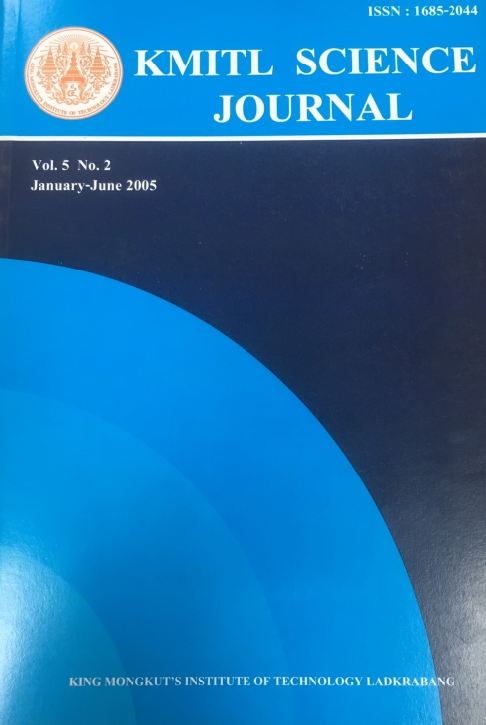Control of Greenhouse Whitefly (Trialeurodes vaporariorum) by Thyme and Peppermint
Main Article Content
Abstract
The insecticidal activities of the essential oils of two medicinal plants (thyme and peppermint) were investigated for the control of greenhouse whitefly (Trialeurodes vaporariorum). The activities of the essential oils were evaluated by fatalities percentage of whitefly after three days of application. The results showed that the most effective essential oils was thyme (Thymus vulgaris).
Keywords: Medicinal Plants, Whitefly fly, Essential Oils
Corresponding author: E-mail: aroiee@ferdowsi.um.ac.ir
Article Details
Copyright Transfer Statement
The copyright of this article is transferred to Current Applied Science and Technology journal with effect if and when the article is accepted for publication. The copyright transfer covers the exclusive right to reproduce and distribute the article, including reprints, translations, photographic reproductions, electronic form (offline, online) or any other reproductions of similar nature.
The author warrants that this contribution is original and that he/she has full power to make this grant. The author signs for and accepts responsibility for releasing this material on behalf of any and all co-authors.
Here is the link for download: Copyright transfer form.pdf
References
[2] Gree, L. 2000 Greenhouse IPM: Sustainable Whitefly Control Pests Management Technical Note. NCAT Agriculture Specialist.
[3] Quarles, W. 2005 Least-Toxic Controls of Plant Diseases. BBG.
[4] Vandermark, T. 2001 Gardening Pests Control with Plants. Page Wise Inc.
[5] McHuge, J. 1991 Monitoring-the First Line of Defence. Greenhouse Grower. February. P.66.
[6] Costa, H.S. and Robb, K.L. 1999 Effects of Ultraviolet-absorbing Greenhouse Plastic Films on Flight Behavior of Bemisia argentifolii (Homoptera: Aleyrodidae) and Frankliniella occidentalis (Thysanoptera: Thripidae). Journal of Economic Entomology, June, pp.557-562.
[7] Moschetti, R. 2003 Biological Control in Alaska Greenhouses.
[8] Anon 1995(a) Controlled Atmosphere to manage Whitefly. The Cut Flower Quarterly, July, pp. 14-16.
[9] Anon 1995(b) Biological Pest Control. Greenhouse Product News, July, p.17.
[10] Cloyd, R.A. 1999 Know Your Friends: Delphastus pusillus: Whitefly Predator. Midwest Biological Control News, October, p.3.
[11] Williams, G. and Pat. 1995 Oil, Soap, Surfactant, and Garlic vs. Whiteflies on Tomatoes. Hortldeas, May, pp.55-56.
[12] Agnew, G.K. Frisvold, G.B. and Baker, P. 2000 Use of Inaect Growth Regularors Changing Whitefly Control Costs in Arizona Cotton. National Agricultural Pesticide Impact Assessment Program.
[13] Daughtrey, M. and Casey, C. 1998 In: Grossman, Joel. Ed. 1996 Highlights from SAF’s Pest Conference. Grower Talks, April, pp. 44-46.
[14] Tripp, K. and Peet, M. 1993 New Use for CO2: Slowing Whiteflies. American Vegetable Growe, November, pp. 43-44.
[15] Duke, S.O. 1985 Biosynthesis of Phenolic Compounds-Chemical Manipulation in Higher Plants. American Chemistry Society Symposium, Ser. 268, pp. 113-131.
[16] Duke, S.O. 1986 Naturally Occurring Compounds as Herbicides. Review Weed Science, 2, 15-44.
[17] Duke, S.O., and Lydon, J. 1987 Herbicides from Natural Compounds. Weed Technology, 1, 122-128.
[18] Duke, S.O., Paul, R.N. and Lee, S.M. 1988 Terpenoids from the Genus Artemisia as Potential Pesticides. American Chemistry Society Symposium, Ser. 380, pp.318-334.
[19] Duke, S.O., Vaughn, KC., Croom, E.M. Jr., and Elsohly, H.N. 1987 Artemisinin, a Constituent of Annual Wormwood (Artemisia annua), is a Selective Phytotoxin. Weed Science, 35, 499-505.
[20] Duke, S.O. 1990 Natural Pesticides from Plant. In: Janick J. and Simon J.E., Eds. Advances in New Crops Timber Press, Portland, OR. pp.511-517.
[21] Yang, R.Z. and Tang, C.S. 1988 Plants Used for Pest Control in China: A Literature Review. Econ. Bot., 42, 376-406.
[22] Rice, E.L 1983 Pest Control with Nature’s Chemicals. University of Oklahoma Press, Norman OK.
[23] Mandava, N.B. 1985 Handbook of Natural Pesticides: Methods. Vol. I Theory Practice, and Detection. CRC Press, Boca Raton, FL.
[24] Gill, S. 2000 Pest Control: Whitefly Control for Cut Flower Growers. The Cut Flower. Quarterly. Vol.12, No.1. pp.26-30.
[25] Klocke, J.A. 1987 Natural Plant Compounds Useful in Insect Control. American Chemistry Soc., Ser. 330, pp.396-415.


